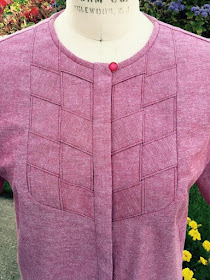Style 114 from the July 2016 issue of Burda Style Magazine features a wonderful blouse with an embellishment technique commonly referred to as the weaving of fabric strips. Burda Magazine refers to the front inset as a "plastron" which is a trimming, like a bib, for a woman's dress. In the late 18th century, a plastron typically featured lace or embroidery.
My version is made from red cotton oxford purchased at Vogue Fabrics in Evanston, Illinois.
The buttonholes are hidden to not detract from the plastron. The fabric strip weaving is not difficult to do but requires accuracy in sewing.
I added an elastic thread loop and button at the top of the buttonhole band to keep the top edge flat against the garment front neckline.
The blouse back is simple with a standard tailoring pleat at center back. Fit is loose and comfortable. Since the fit was loose, I made just one sleeve for the muslin. On a fitted garment, I would add both sleeves to check fit across the shoulders, chest, and back.
 |
| No pattern changes, not even the addition of a bust dart! |
Construction Notes:
 |
| Stitching line are marked in blue. |
 |
| I prefer the look of the fabric strip on the left. It has no top-stitching. I decided to top-stitch the strips because I wanted the blouse to launder well and not require complicated pressing. |
 |
| View of inside of the plastron |
 |
| If you mark and stitch accurately, the right and left sides of the plastron will match nicely. |








Oh Ann I am so pleased you have featured this blouse, as I purchased the Burda Magazine which has this pattern.
ReplyDeleteNow I have seen your construction notes I will have a play and make this, once I have finished my knit dress.
As always you have made the garment beautifully. I have some spare linen so I think I will use that.
Thank you for sharing.
I thoroughly enjoyed making the plastron. I am happy to hear you were able to access the website as I have been making changes to the blog template all afternoon and that makes viewing difficult. I was able to add an Instagram feed but still no luck with Pinterest.
Delete